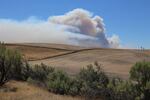
Smoke from the Substation Fire rises over the hills near Moro, Oregon, Wednesday, July 18, 2018.
Molly Solomon / OPB
Another long, hot wildfire season is underway in the Pacific Northwest. A long list of fires has burned this summer across the region, torching native plants as they spread across the dry land.
Once the fires are extinguished, another threat lingers: The burned landscapes provide an opportunity for invasive species to thrive, forcing out essential native plants.
It's a challenge that Jerry Erstrom knows all too well. He worked as a fire manager with the Bureau of Land Management for 30 years. In that time he saw invasive plants spread across the state, bringing more fire hazards with them.
“When we’ve lost some of our native species — grasses and such — these invasives tend to move in,” Erstrom said. “They green up a little earlier in the spring, they ripen a little earlier in the summer and they tend to create quite a fire hazard because they’re very fine and very flammable.”
Erstrom said the growth of invasive species where he lives in Malheur County has been dramatic.
“When I first started my career in the BLM, there were only two patches of medusahead rye in the county,” he recalled. “At this point in time, there something between 500,000 and a million acres.”
After retiring from the BLM, he got to work growing plants like yarrow flax and sagebrush, harvesting seeds that can take hold in the ground after a fire and ward off the spread of less desirable species.
Today, he sells those seeds to wilderness management agencies across the western United States.
“They will evaluate and prioritize the areas that need restoration,” Erstrom said. “Obviously the ones that are most vulnerable to domination by something nondesirable will be the ones that get priority to be fixed.“
But Erstrom said despite widespread efforts to protect and restore lands that have been scorched by wildfires, human intervention can only go so far.
“A timely rainstorm in the spring can make a hero out of any restoration specialist," he said. "Or the lack thereof can make him a villain. So it depends on which side you’re on when the rain comes.”
To listen to the entire conversation, use the audio player at the top of this story.
